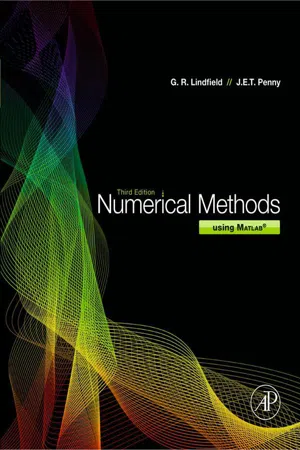
This is a test
- 552 pages
- English
- ePUB (mobile friendly)
- Available on iOS & Android
eBook - ePub
Book details
Book preview
Table of contents
Citations
About This Book
Numerical Methods using MATLAB, 3e, is an extensive reference offering hundreds of useful and important numerical algorithms that can be implemented into MATLAB for a graphical interpretation to help researchers analyze a particular outcome. Many worked examples are given together with exercises and solutions to illustrate how numerical methods can be used to study problems that have applications in the biosciences, chaos, optimization, engineering and science across the board.
- Over 500 numerical algorithms, their fundamental principles, and applications
- Graphs are used extensively to clarify the complexity of problems
- Includes coded genetic algorithms
- Includes the Lagrange multiplier method
- User-friendly and written in a conversational style
Frequently asked questions
At the moment all of our mobile-responsive ePub books are available to download via the app. Most of our PDFs are also available to download and we're working on making the final remaining ones downloadable now. Learn more here.
Both plans give you full access to the library and all of Perlego’s features. The only differences are the price and subscription period: With the annual plan you’ll save around 30% compared to 12 months on the monthly plan.
We are an online textbook subscription service, where you can get access to an entire online library for less than the price of a single book per month. With over 1 million books across 1000+ topics, we’ve got you covered! Learn more here.
Look out for the read-aloud symbol on your next book to see if you can listen to it. The read-aloud tool reads text aloud for you, highlighting the text as it is being read. You can pause it, speed it up and slow it down. Learn more here.
Yes, you can access Numerical Methods by George Lindfield,John Penny in PDF and/or ePUB format, as well as other popular books in Mathematics & Applied Mathematics. We have over one million books available in our catalogue for you to explore.
Information
1
An Introduction to Matlab®
Matlab® is a software package produced by The MathWorks, Inc. (www.mathworks.com) and is available on systems ranging from personal computers to supercomputers, including parallel computing. In this chapter we aim to provide a useful introduction to Matlab, giving sufficient background for the numerical methods we consider. The reader is referred to the Matlab manual for a full description of the package.
1.1 The Matlab Software Package
Matlab is probably the world’s most successful commercial numerical analyis software package, and its name is derived from the term “matrix laboratory.” It provides an interactive development tool for scientific and engineering problems and more generally for those areas where significant numeric computations have to be performed. The package can be used to evaluate single statements directly or a list of statements called a script can be prepared. Once named and saved, a script can be executed as an entity. The package was originally based on software produced by the LINPACK and EISPACK projects but currently includes LAPACK and BLAS libraries which represent the current “state-of-the-art” numerical software for matrix computations. Matlab provides the user with
1. Easy manipulation of matrix structures
2. A vast number of powerful built-in routines that are constantly growing and developing
3. Powerful two- and three-dimensional graphing facilities
4. A scripting system that allows users to develop and modify the software for their own needs
5. Collections of functions, called toolboxes, that may be added to the facilities of the core Matlab. These are designed for specific applications, for example, neural networks, optimization, digital signal processing, and higher-order spectral analysis.
It is not difficult to use Matlab, although to use it with maximum efficiency for complex tasks requires experience. Generally Matlab works with rectangular or square arrays of data (matrices), the elements of which may be real or complex. A scalar quantity is thus a matrix containing a single element. This is an elegant and powerful notion but it can present the user with an initial conceptual difficulty. A user schooled in such languages as C++ or Python is familiar with a pseudo-statement of the form A = B + C and can immediately interpret it as an instruction that A is assigned the sum of values of the numbers stored in B and C. In Matlab the variables B and C may represent arrays so that each element of the array A will become the sum of the values of corresponding elements of B and C.
There are several languages or software packages that have some similarities to Matlab. These packages include
APL. The letters stand for A Programming Language. This language was designed mainly for manipulating arrays. It contains many powerful facilities but it used nonstandard symbols and the syntax was unusual. The keyboard had to be remapped for these special characters. This language had an important influence on other languages and was replaced by AP...
Table of contents
- Title page
- Table of Contents
- Copyright
- Dedication
- Preface
- List of Figures
- 1. An Introduction to MATLAB®
- 2. Linear Equations and Eigensystems
- 3. Solution of Nonlinear Equations
- 4. Differentiation and Integration
- 5. Solution of Differential Equations
- 6. Boundary Value Problems
- 7. Fitting Functions to Data
- 8. Optimization Methods
- 9. Applications of the Symbolic Toolbox
- Appendices
- Solutions to Selected Problems
- Bibliography
- Index